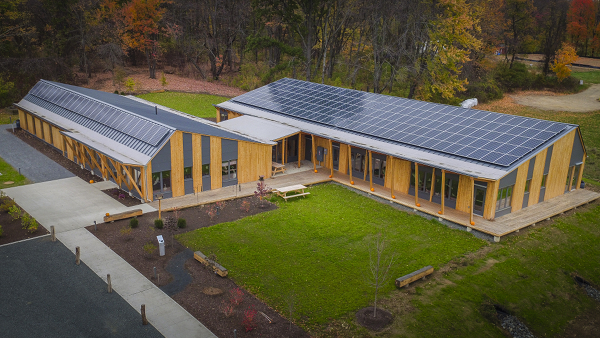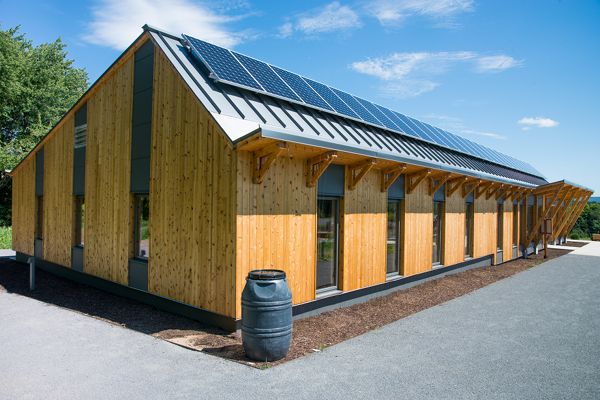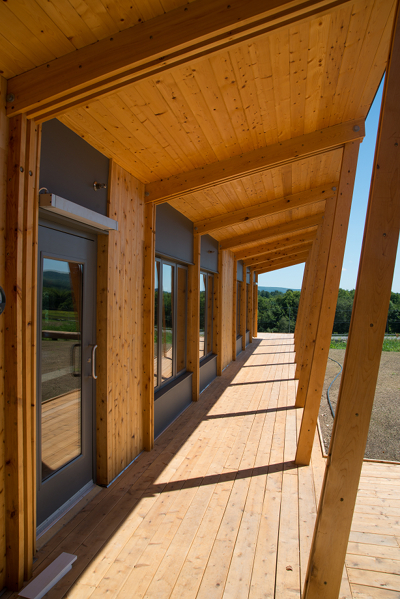Project Subtitle:
Project Description:
The Hitchcock Center for the Environment (HCE) is a nonprofit environmental education center in Amherst, MA that has served Western Massachusetts for over 50 years. The Center serves over 9,000 visitors annually through educational programing and events that are open to the public. (www.hitchcockcenter.org) In 2016, HCE completed a new 8,900 square foot net zero energy and water environmental center. In planning for its new facility, HCE needed additional educational space for programing and a building that amplified its environmental education mission as a leader in sustainable design and operation. HCE built to the highest standard of sustainable development in the built environment by taking the Living Building Challenge (LBC). This required HCE to meet over 20 rigorous performance standards that include zero net energy and water and the use of locally sourced, non-toxic materials. The Hitchcock Center is excited to begin the 12-month audit period toward achieving LBC, estimated to begin in early 2017.
Building Type Summary:
Other Awards:
Award submissions pending.
Address:
Elevation:
Lat. / Long.:
Location Type:
Climate Region:
Solar Insolation:
Annual HDD :
Annual CDD:
HDD Base Temp:
CDD Base Temp:
Occupancy Type and Details:
The building is owner-occupied, with approximately 14 staff (9.5 FTE). Occupant hours are standard M-F 8AM-5:30PM. Weekend hours include one Saturday per month at 4 hours. Evening programs average one per week over 14 weeks from 6:30-8:30PM. Occupancy hours are projected to increase over time.
Conditioned Floor Area:
Conditioned Building Volume:
Semiconditioned Floor Area:
Unconditioned Floor Area:
Multiple buildings?:
Total number of units in project (all buildings):
Total floor area of project (all buildings):
Historic?:
If historic, historical significance:
Not applicable.
Completion date:
Site description:
The site is located on land owned by Hampshire College. It was a former apple orchard and as a result was contaminated from lead arsenate spraying. The Hitchcock Center developed a plan to remediate soils on the site by stripping the top 7-9 inches off the surface. Contaminated soil was buried under the parking area, reducing costs for trucking and disposal off site. New clean soils from local sources were brought in to the site for landscaping and grading work.
Materials:
Materials for this project were required to meet the Living Building Challenge requirements. These included local/regional sourcing and vetting against the Red List.
Certified sustainably harvested wood
Cradle to cradle carpets, windows blinds
native landscaping
Local soils
No VOC paints and finishes
Energy Highlights:
The Hitchcock Center's building uses a 60kw photovoltaic array comprised of Sunpower SPR-E20-327-COM modules. Solaredge inverters convert DC to AC current.
R values in trade for larger pv array
LED lighting
Heating and cooling set points
building management system
LCA Description:
Not applicable.
HERS Index:
Energy Star Score:
Annual renewable energy generated:
Electric Utility Company:
Gas Utility Company:
Datasets and Utility Bills sources and reliability:
Energy Model prepared by Buro Happold Engineering. (Eversource electric bills, ultimate source)
Natural gas amount (purchased energy):
Energy Storage Capacity:
Energy Storage type:
Building uses the northeast energy grid to store excess power, plus there is thermal mass in the floor slab that stores some heat energy during the day and deliver it at night.
CHP System Description:
Not applicable
CHP Electrical Output:
CHP Thermal Output:
Subslab assembly:
4-inches of expanded polystyrene, continuous under slab, and around foundation wall
Slab edge assembly:
Slab edge is isolated from grade our out door air by 4 inches of expanded polystyrene insulation.
Foundation wall assembly:
Conventional poured in place concrete foundation wall wrapped with 4 inches of expanded polystyrene insulation.
Above grade wall assembly:
siding over plywood sheathing, over 6 inches polyisocyanurate insulation (2 layers of 3 inch, joints staggered), over air and vapor barrier, over 3/8 inch plywood sheathing, over 1.25 inches tongue and groove sheathing
Flat attic assembly:
Not applicable
Cathedral ceiling assembly:
roofing over plywood sheathing, over 6 inches polyisocyanurate insulation (2 layers of 3 inch, joints staggered), over air and vapor barrier, over 3/8 inch plywood sheathing, over 1.25 inches tongue and groove sheathing
Door Area:
Space heating - Manufacturer & Model:
Space heating - capacity:
Space cooling - Manufacturer & Model:
Space cooling - capacity:
Domestic hot water - Manufacturer & Model:
Domestic hot water - capacity:
Domestic hot water - efficiency:
Ventilation - Manufacturer & Model:
Process:
We used an integrated process that is highly collaborative. Over 8 different disciplines were represented in our design team, from mechanical engineers and landscape designers to our construction manager and exhibit designers. As well, our environmental educators and staff of the Hitchcock Center had a central role at the design table. The whole project team was tasked with the entire building and all of its systems together, emphasizing connections and improving communication among professionals and stakeholders throughout the life of a project. Disciplinary boundaries were broken down and linear planning was reduced to promote great efficiency and effectiveness in the design process.
Our integrated-design approach required more time on the the front-end – from concept design to construction documents - nearly two years but the outcome is a beautifully executed and on-budget building.
Design for Adaptability:
Open column free spaces and slab throughout.
Other Software tools:
ArchiCAD
Energy Modeling Software:
IES Virtual Environment (IES) version 2014.2.1.0
Outcome of project goals:
The project goal was to design and build a building to meet full Living Building Challenge certification. Following construction and occupancy, the building enters a 12-month audit period. This period has not yet begun.
Discrepancies:
Not enough data is available to date. Occupants have been in the building for only 2 months.
Finances Description:
Project funding was raised from a cross section of sources including community donors, foundation grants, state grants and funding sources, and federal grant sources based on a fundraising plan.
Total Cost of Project:
Construction hard cost:
Gross Cost of Renewable Energy System:
Value of Tax Credits for renewable energy systems:
Net Cost of renewable energy systems:
Federal incentives:
Grant funding: Institute for Museum and Library Services
State incentives:
MA Department of Energy Resources Pathways to Zero Grant Program
MA Environmental Bond Bill
MA Cultural Facilities Funding
Local incentives:
Local community donors.
Utility incentives:
Eversource
Annual Electric Savings:
Annual Revenue from SRECs or other renewable energy credits:
NESEA Awards:
Not applicable
Published References:
"A watershed moment" Concrete Decor, October, 2016. http://reader.mediawiremobile.com/ConcreteDecor/issues/109161/viewer?pag...
"Hitchcock celebrates new $5.8M home" Daily hampshire Gazette, October 1, 2016 http://www.gazettenet.com/New-Hitchcock-Center-unveiled-5123431
"A river runs through it" PROSOCO, September 15, 2016 http://www.prosoco.com/a-river-runs-through-it/
"Construction of new Hitchcock Center for Environment building will begin with groundbreaking May 1" Daily Hampshire Gazette, April 25, 2015 http://www.gazettenet.com/Archives/2015/04/amhitchcock-hg-042515
"Hitchcock Center takes 'Living Building Challenge'" Going Green, Feb./March/April/ 2015. http://hitchcockcenter.org/wp/wp-content/uploads/2015/04/Hitchcocks_Take...
"State grant $510,000 for ‘zero net energy’ projects in Amherst, Northampton and Easthampton" Daily Hampshire Gazette, November 5, 2014. http://hitchcockcenter.org/wp/wp-content/uploads/2014/12/State_grants_51...
Special architectural measures:
The building is located on a site with clear southern aspect for optimal solar gain. Triple glazed Alpen windows (71) and daylighting strategies were used throughout. There is some thermal mass in the concrete slab flooring.
Building envelope as engineering measure. Extensive solar studies to locate for optimal solar gain,
Roof overhangs.
Vegetated screen
Windows limited on north side
Energy Strategies:
The structure has a high performance building envelope. It uses a highly efficient air source heat pump system HVAC system, including energy recovery ventilation. Finally, it utilizes a large PV array for energy generation.
Energy Use and Production Documentation:
Subslab R-value:
Slab edge R-value:
Foundation wall R-value:
Above grade wall R-value:
Flat attic R-value:
Cathedral ceiling R-value:
Average window U-factor:
Solar Heat Gain Coefficient:
Visible Light Transmittance:
Door U-Factor:
Cost per square foot of Conditioned Space:
Air Changes per hour, ACH50:
Project Photos:





Number of Bathrooms:
Scope Description:
The project was to build a 8,500 square foot environmental education center, to meet the Living Building Challenge.
Site conditions:
Renewable Energy Sources:
Other Purchased Fuels Description:
Not applicable
Storage Strategies & System Details:
As noted above, the northeast grid stores excess electric energy. We have not calculated the thermal mass impact on the overall energy demand of the building.
CHP Fuel Use:
Summary of enclosure strategy/description:
The envelope design is based on continuity of the insulation layer and air barrier from footing to eave to ridge to eave to footing. Great effort was made to eliminate thermal bridging. For instance, all roof overhangs (used to harvest rainwater) are independently framed outboard of the insulation layer and air barrier. The actual R-value is not remarkable - R39 - but the designers believe continuity makes up for that. For instance, our recent blower door test shows an extremely tight building meeting Passive House standards.
Roof Assembly:
See cathedral ceiling assembly.
Window Description:
Alpen 725 Series WIndows
Door Description:
Hollow metal door with polyurethane core. Ceco Door, Assa Abloy 1-3/4" Trio-E Door.
Number of Bedrooms:
Project Team:
Team Member:
Team Members:
Architects: designLAB Architects (Sam Batchelor and Kelley Ard Haigh)
Builder: Wright Builders (Mark Ledwell, Jonathan Writh, Jim Small)
MEP Engineer: Buro Happold Engineering (Kaye Palomo and John Swift)
Civile Engineer: Berkshire Design Group (Christopher Chamberland)
Water System Engineer: Buro Happold Engineering (Ronald Furbish)
Structural Engineer: Structures Workshop (Erik A. Nelson)
Sustainability Consultant: Linnean Solutions (Jim Newman)
Materials Vetting (Red List): Integrated EcoStrategy (Charley Stevenson)
Lighting Designer: Sladen Feinstein Integrated Lighting
Landscape Designer: Stephen Stimson Associates Landscape Architects (Greg Tuzzolo)
Solar Installer: PV Squared (John Child and Chris Krezmien)
Commissioning Agent: Collier's International (Robert Lee)
Owner's Project Manager: Chris Riddle (retired, Kuhn Riddle Architects)
Hitchcock Center Staff: Julie Johnson, Executive Director and Jessica Schultz, Communication and Living Building Coordinator
